40.15% 41.64% 56.73% 43.27% 8.77% 5.66% Location New Zealand | 50.58% 49.42% Silver Fern (Black & White) Koru Dates 20 Nov 2015 – 24 Mar 2016 | |
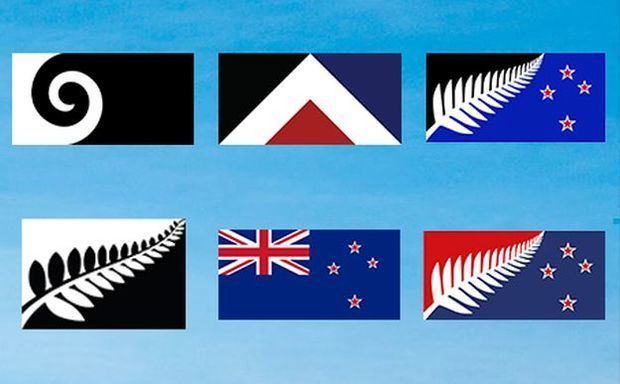 | ||
Turnout First referendum: 1,546,734 (48.78%)
Second referendum: 2,140,805 (67.78%) | ||
Two New Zealand flag referendums were held by the New Zealand government in November/December 2015 and March 2016 and resulted in the retention of the current flag of New Zealand.
Contents
- Background
- Legal issues
- Use of current flag
- Cost of transition
- Cross party group
- Flag Consideration Panel
- Referendums legislation
- Public engagement process
- Long list
- Shortlist announcement
- Criticism of selection
- Red Peak
- Priority
- Cost
- Bias
- Order of questions
- Timing
- Inclusion of Red Peak flag
- First referendum
- Second referendum
- Result by electorate
- Multiple voting reports
- References
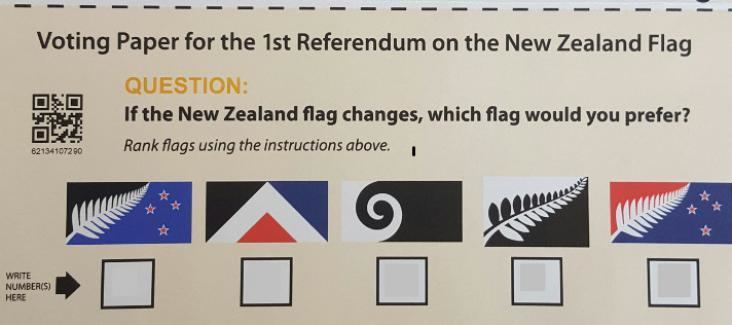
The first referendum to determine the preferred alternative flag took place between 20 November and 11 December 2015 and asked, "If the New Zealand flag changes, which flag would you prefer?" Results show the black, white, and blue Silver fern flag by Kyle Lockwood advancing to the second referendum.
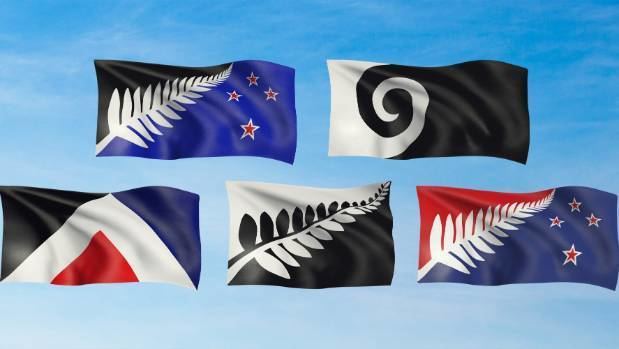
The second referendum took place between 3 and 24 March 2016 and asked voters to choose between the selected alternative (the Silver Fern Flag) and the existing New Zealand flag.

Reception of the process was critical, with no great enthusiasm shown among the public.
Background
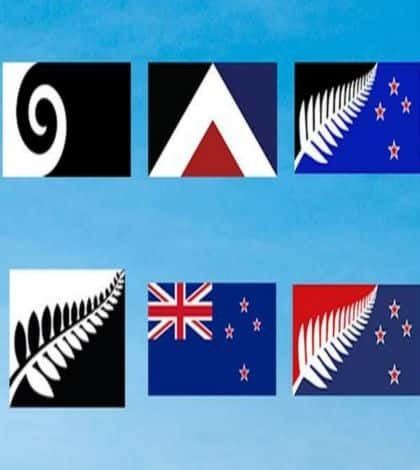
New Zealand has a history of debate about whether the national flag should be changed. For several decades, alternative designs have been proposed, with varying degrees of support. There is no consensus among proponents of changing the flag as to which design should replace the flag.
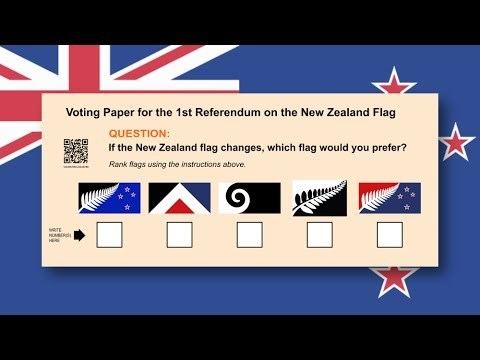
In January 2014, Prime Minister John Key floated the idea of a referendum on a new flag at the 2014 general election. The proposal was met with a mixed response. Then in March, Key announced that New Zealand would hold a referendum within the next three years asking whether or not to change the flag design, should the National Party be re-elected for a third term. Following National's re-election the details of the referendum were announced.
Legal issues
The results of both referendums are binding, meaning the flag with the most votes in the second referendum is the official flag of New Zealand. In the unlikely event the second referendum vote was tied, an assumption for the status quo would have applied.
If a new flag design had been chosen, assuming no intellectual property issues, the Flags, Emblems and Names Protection Act 1981 would have been updated to reflect the new design six months to the day after the second referendum results were declared (or earlier by Order in Council). The current flag would have remained the official flag until then; for example, the current flag would have been flown during the 2016 Summer Olympics, four months after the second referendum took place, regardless of the results of the second referendum. This result would not have changed the coat of arms (which includes the current national flag), national Māori flag, nor the flags of Associated States (Cook Islands and Niue), nor the New Zealand Red Ensign (merchant marine), White Ensign (naval), (both incorporating Union Flags) police flag and fire service flag (which are based on the current flag). It would also not change New Zealand's status as a constitutional monarchy in the Commonwealth of Nations.
Use of current flag
If the flag had been changed, it would have been legal to have continued to fly the current flag of New Zealand, which would have been "recognised as a flag of historical significance." Old flags would have been replaced once worn out. Official documents depicting the current flag, such as driver licences, would have been phased out as a matter of course – in the case of driver licences, this would have been when licences are renewed and would therefore have taken up to 10 years.
New Zealand Government ships and those non-government ships flying the New Zealand flag (instead of the New Zealand Red Ensign) would have been given an extra six months to change their flag to the new design. Ships flying the New Zealand Red Ensign and ships belonging to the New Zealand Defence Force would not have been affected by any flag changes, nor would any New Zealand-based ships registered to foreign countries.
Cost of transition
The estimated cost of updating government flags and Defence Force uniforms is at least $2.69 million. Other unknown costs include updating government ships, updating trademarks and logos, publicity of the new flag, excess stock of old flags (including products and souvenirs containing it), and updating all flags, packaging, uniforms and marketing material in the private and sporting sectors. The government would not have provided compensation for the cost of adopting the new flag.
Cross-party group
Shortly after announcing the referendum, party leaders were invited to a cross-party group. The purpose of the cross-party group was to review draft legislation allowing for the referendums to take place, and to nominate candidates for a Flag Consideration Panel by mid February 2015. Members included Bill English (Finance Minister and leader of the group), Jonathan Young (representing National), Trevor Mallard (representing Labour), Kennedy Graham (representing Green), Marama Fox (representing Māori), David Seymour (representing ACT) and Peter Dunne (representing United Future). New Zealand First refused to participate.
Flag Consideration Panel
The Flag Consideration Panel was a separate group of "respected New Zealanders" with representative age, regional, gender and ethnic demographics. Their purpose was to publicise the process, seek flag submissions and suggestions from the public, and decide on a final shortlist of four suitable options for the first referendum. Public consultation took place between May and June 2015. The panel stated that it consulted vexillologists (flag experts) and designers to ensure that the flags chosen were workable and had no impediments. The members of the Flag Consideration Panel were:
Referendums legislation
The legislation to set up the referendums passed its first Parliament hearing on 12 March 2015 with a vote of 76 to 43. It was then considered by the Justice and Electoral Select Committee. During their public submission intake phase the RSA launched the "Fight for the Flag" campaign, also backed by New Zealand First, to reverse the question order and first ask if New Zealanders want a flag change. Labour MP Trevor Mallard presented a petition signed by 30,000 people to the Committee, asking for a keep/change question to be added to the first referendum, similar to the 2011 voting system referendum. During its second hearing in Parliament, MP Jacinda Ardern proposed an amendment so that the second referendum would only take place if turnout for the first referendum was at least 50%, as a way of ensuring majority rule and reducing costs if the public was apathetic. Ardern's proposal was voted down and the bill was passed as-is on 29 July 2015.
Public engagement process
As part of the public engagement process, flag designs and symbolism/value suggestions were solicited until 16 July, which resulted in a total of 10,292 design suggestions. All 10,292 submitted design proposals were presented to the public on the New Zealand government website.
During the public engagement process, the Flag Consideration Panel travelled around the country for workshops and hui. These in-person consultation events were noted to have markedly low attendance. The consideration panel noted strong online engagement with over 850,000 visits to the website and 1,180,000 engagements on social media.
The panel reported that feedback found the themes of freedom, history, equality, respect and family to be the most significant to New Zealanders, however it was later revealed that those themes were dwarfed by the amount of feedback critical of the flag change process. From the submitted designs they found the most common colours were white, blue, red, black, and green. The most common elements incorporated into the flag designs were the Southern Cross, silver fern, Kiwi, and koru. The main themes incorporated into the designs were Māori culture, nature and history.
Long list
From the 10,292 submitted designs, the Flag Consideration Panel deliberations resulted in their selection of a 'long list' shortlist of 40 designs (announced to the public on 10 August 2015).
Shortlist announcement
On 1 September 2015, the Flag Consideration Panel announced the final four designs to be included in the first referendum.
Criticism of selection
The flag design shortlist was met with negative response from some members of the public, professional designers and vexillologists. The selection was lambasted as unappealing, clichéd, dull and too logo-like. There were complaints that the four designs were far too similar to each other, as only one does not feature a large silver fern dividing the field, and two are identical except for a colour choice. The two Lockwood proposals were likened to the design of a beach towel. until Lockwood pointed out that most national flags were made into beach towels. Some commentators also felt that the Flag Consideration Panel was never qualified to make an adequate design selection, since none of its members had any credentials or experience in the fields of graphic design, art or vexillology. The panel stated that it consulted vexillologists and designers to ensure that the flags chosen were workable and had no impediments. According to journalist Grant McLachlan, the panel consulted a Nike shoe designer and not any vexillologists.
Nándor Tánczos opined that the Flag Consideration Panel denied the public a chance to choose their favourite designs by deciding on their behalf, and ended up with a selection bad enough to potentially prevent a flag change as the referendum outcome.
Red Peak
After public disappointment with the official shortlist of four options, a social media campaign was launched on 2 September for the Red Peak flag, a design well-liked by supporters of changing the New Zealand flag who disapprove of the silver fern flag and other similar proposed designs. Despite not being selected by the official Flag Consideration Panel, the Red Peak design was supported by a grassroots social media campaign. An online petition to support inclusion of the flag design as an option for the referendum gained support from 50,000 petitioners in less than two weeks, and was handed over to Parliament by David Seymour on 16 September 2015.
On 23 September, the Green Party MP Gareth Hughes attempted to introduce a bill to parliament to include Red Peak as an option in the first referendum. The bill's introduction was blocked by New Zealand First. Prime Minister John Key confirmed that the National Party would pick up the legislation, meaning the Red Peak flag was added as a fifth option in the flag referendum. Red Peak gained 10.9% of the vote in the first referendum.
Priority
Opposition parties condemned the flag as low priority compared to current issues in the public consciousness such as the education system, lack of funding to district health boards, cuts to police services, child poverty, gridlock in Auckland among other transportation problems, lack of economic diversity, immigration, the housing crisis, Māori representation, and lack of written constitution. Trevor Mallard and Phil Goff cited the results of recent opinion polls that showed widespread public opposition or apathy (results are shown in the section below). These were used to argue that the referendums were unnecessary as the question was already answered by the public as a clear negative.
Cost
Opposition parties, Royal New Zealand Returned and Services' Association (RSA) president Barry Clark and members of the public criticised the referendum plan for costing $26 million which could be spent on other issues. Once the Flag Consideration Panel started its national tour, the cost of the campaign was again criticised. Various charities and social services emphasised how much $26 million could fund to help poverty alleviation, public health and education. Also, the $4 million publicity campaign was contrasted with the low turnout; at the Christchurch event only ten people arrived.
John Key defended the cost of the referendum by stating that it is the price to ensure a genuine democratic process and would be a one-off cost for the next "50 to 100 years" regardless of the result. David King pointed out that a stronger brand image for the country could lead to a net financial gain, especially through exports and tourism.
Bias
The public opposition to a flag change was also contrasted with prime minister John Key's disproportionate drive to run the referendums, and members of parliament accused him of attempting a flag change as his "vanity project" or populist bread and circuses. New Zealand First accused the referendum of acting as a distraction from poverty and housing issues.
Various members of parliament accused the process and documents of being biased. Trevor Mallard and Phil Goff claimed that the final list of members of the Flag Consideration Panel was numerically slanted towards those nominated by the National Party, despite the shortlist of candidates being roughly neutral. Kennedy Graham expressed scepticism at the official rationale that the referendums simply reflected a pre-existing public debate, and argued that recent discussion was actually deliberately sparked by the referendums announcement itself. Denis O'Rourke said that the shortlisting process was undemocratic because the Flag Consideration Panel would select the final flag design options on behalf of New Zealanders, and asking the public to choose between alternative designs before asking if they wanted a change was intentionally manipulative. Stuart Nash presented quotes in the Regulatory Impact Statement document admitting that referendum options were restricted by prior decisions by the National Party dominated Cabinet and prime minister, accusing them of pre-determining the process.
A third-party analysis of submissions to the consideration panel's StandFor.co.nz website revealed that negative submissions were filtered out and disregarded in the panel's report and the associated and widely publicised word cloud. According to this analysis, the largest term in the official word cloud, "equality", appeared in 4.89% of comments, whereas "keeping the current flag" was the most common theme and represented 31.96% of comments. According to opposition MP Trevor Mallard this shows that the flag change process is suffering from "total spin" and that the panel is pushing to change the flag in breach of its mandate to be neutral.
Documents revealed that Flag Consideration Panel judge Julie Christie is a board member of the New Zealand Trade and Enterprise (NZTE) body New Zealand Story where she "had formally agreed to support the use of the NZ Way Fern Mark in any flag design". This fern design ended up as one of the shortlist entries. Christie had declared this as a potential conflict of interest but it was dismissed as minor.
Order of questions
During the first Parliamentary hearing, Labour Party, NZ First, Green Party and Māori Party expressed dissatisfaction with the order of the questions and said that the public should first be asked whether they want a change, and continue with a second referendum only if they do, or both questions compacted into one referendum, which could potentially save millions of dollars. David Seymour (ACT's representative in the Cross-Party Group) said that the planned order made sense, as the public would need to see the alternative designs before deciding on a change. Professor John Burrows, chair of the Flag Consideration Panel, agreed that familiarity with proposals is a prerequisite for a properly informed decision about them.
Timing
Members of parliament were also concerned about the timing. Some expressed disgust at the timing of the bill just before the centenary of the Gallipoli landing, some said the process was rushed, and Louisa Wall said that no significant event had occurred to warrant a flag change at this time. Nándor Tánczos noted a common perception that removing a symbol of British sovereignty from the flag before constitutionally removing British sovereignty is tokenistic.
Inclusion of Red Peak flag
In September, the initial shortlist of four flags was amended to include the Red Peak flag after an online petition accrued 50,000 signatures. NZ First leader Winston Peters and former National Party official Grant McLachlan said that instead of respectfully incorporating wider public opinion, this inclusion was an ad hoc deference to a trendy but unrepresentative social media campaign. McLachlan demonstrated that online signatures could easily be forged by recording himself signing the petition sixteen times and fraudulently impersonating members of parliament. They accused the campaign of having dubious credibility and chided the government for considering the petition without checking the details sufficiently.
First referendum
If the New Zealand flag changes, which flag would you prefer?
The first referendum started on 20 November 2015 with voting closing three weeks later on 11 December 2015. Preliminary results were released on the night of 11 December; official results were declared on 15 December. Using the preferential voting system, it asked voters to rank the five shortlisted flag alternatives in order of preference. The most popular design would contend with the current national flag in the second referendum.
Opponents of flag change encouraged members of the public to abstain from voting, render the voting paper invalid or strategically vote for the worst alternative flag as a protest.
Non-transferable votes include voting papers that were not able to be transferred, as all of the preferences given had been exhausted. Informal votes include voting papers in which the voter had not clearly indicated their first preference. Invalid votes include voting papers that were unreadable or cancelled.
The added work of calculating results for individual electorates under preferential voting made no vote breakdown by electorate be available.
Second referendum
What is your choice for the New Zealand flag?
The second referendum started on 3 March 2016 with voting closing three weeks later on 24 March 2016. It asks voters to choose between the existing New Zealand Flag and the preferred alternative design selected in the first referendum. On 24 March 2016, the preliminary results of the second referendum were announced with the current flag winning 56.7% compared to 43.3% for the new flag.
Informal votes include voting papers where the voter had not clearly indicated their preference (e.g. votes returned blank or voting for both options).
Invalid votes include voting papers that were unreadable or cancelled.
Result by electorate
Of New Zealand's 71 electorates, only six had a majority vote in favour of the alternative flag: Bay of Plenty, Clutha-Southland, East Coast Bays, Ilam, Selwyn and Tāmaki.
Multiple voting reports
After the first referendum, the Electoral Commission referred seven cases of people apparently voting more than once to police.
On 8 and 9 March, the Electoral Commission referred four more cases of apparent multiple voting to police. This included one case of an Auckland man allegedly voting with 300 ballot papers stolen from other people's mailboxes.
Voting more than once is known as personation and is identified as a corrupt electoral practice under both the Electoral Act 1993 and the Flag Referendums Act. A person convicted of personation is liable to up to two years' imprisonment and a fine up to $40,000, and carries a mandatory disqualification from enrolling or voting for three years.
